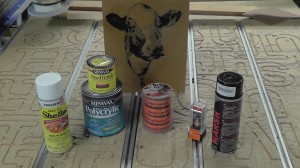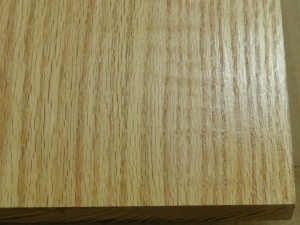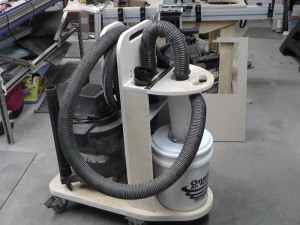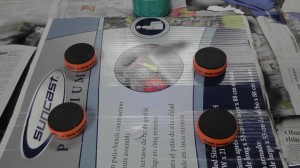APPLYING FINISH
Applying finish to a projects can make or break the entire process. As I previously mentioned, my client provided me with the raw material to make this project. Oak is not the best choice for a sign. Oak has a very strong grain patten which can detract from the details of the sign. My client loved the look of natural oak and asked that the wood just be clear coated.
I looked at a variety of different clear coating and decided I would try a water based polyurethane finish. Since the sign was only going to be displayed indoors at cow competitions I was not overly concerned about with protecting the sign from the elements but I was concerned with having a good looking finish. Indoor signs are often closer to the viewer than an outdoor sign so the finish has to look really good. I knew that several coats of a poly finish would give a good look if the wood was prepared properly first.
SANDING
The board I received was already planed flat when I received it. So I started out preparing the board for the finish by sanding the entire board with a course grit sand paper on my random orbit sander. After I finished with the course paper I vacuumed up the sawdust with my shop Vacuum with Dust Deputy Cyclone separator and bristle brush attachment. I then switched to a medium grit (80 grit) paper and repeated the process, I continued down to a fine grit (120 grit) disk. My random orbit sander has a dust collection hose attached and I used it while sanding to cut down on the mess. Once I was satisfied with the surface finish I switched to the bristle brush on the vacuum and cleaned the area. I then left the shop for a while and allowed the dust to settle before applying finish.
SANDING SEALER
To seal the grain of the wood I used three spray coats of Zinssers Bulls Eye spray shellac. The Shellac sprays on evenly and drys in about 15 minutes. I let each coat dry for a half hour before sanding, vacuuming and spraying with the next coat. I sanded each coat with fine sandpaper (120 grit). I let the final coat dry over night because it was late.
CLEAR COAT
The following morning I applied the first coat of clear finish. I chose to use Minwax Polycrylic Satin finish Water based Polyurethane. This is the first time I have used this brand and I was happy with the results. The coating cleans up with soap and water and doesn’t smell bad like regular Poly. I used a brush to apply the finish. I put on 3 coats but only sanded after the first coat. I didn’t get brush marks in the finish so I was happy. I just discovered they also make Minwax Polycrylic in a spray can. I plan to try some on my next project.
PAINTING TWO SIDES AT ONCE
One way I saved time while making this sign was to use painters pyramids under the stock when I applied the finish. The painter’s pyramids are made of plastic and have a rounded tip which prevents the finish from sticking. To use the painter’s triangle I applied finish to one side of the board and it’s edges. I then flip the still wet board over and apply finish to the other side. Because the triangles hold the board above the work surface, air can get in an dry the board faster.
Painter’s pyramids are great for painting but not so good for sanding. This project was the first time I got to try Bench Cookies. Bench Cookies are similar to hockey pucks with a rubber surface on them so they don’t slip on the workbench. The workpiece is very stable on the Bench Cookies provided you place them in the right area. I like them and I will use them again.
WHY FINISH NOW?
Many of you may be wondering why I am discussing finishing the workpiece now before the sign is completed. The reason I am doing the finish now is that some of the painting we are planning to do later will be easier to clean up if it is applied to a finished surface. Unfinished wood soaks up much more pigment than finished wood will. The last thing we want to see is paint bleeding through the \grain of the board and ruining the entire sign.
WHAT’S NEXT?
In the next post I will show the test pieces I carved and discuss the new finishing techniques I used. I appreciate everyone who has hung in this long. As you can see making a CNC sign project can take a while to execute especially when you are new. If these tutorials have been useful for you please consider leaving a comment here on the blog. As always comments are appreciated and really help me make better articles. If you like the tutorials why not share them on Facebook or Twitter.
CNC SIGN PROJECTS:





[…] PART SEVEN […]
[…] PART SEVEN […]
[…] PART SEVEN […]
[…] PART SEVEN […]
[…] PART SEVEN […]
[…] series. Part seven of the CNC Sign Projects tutorial is about applying finish to the oak board. APPLYING FINISH Bill Attached Thumbnails __________________ Making the world a better place, one […]
[…] PART SEVEN […]
[…] PART SEVEN […]
[…] PART SEVEN […]
[…] PART SEVEN […]